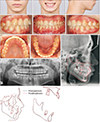1. Liou EJ, Chen LI, Huang CS. Nickel-titanium mandibular bonded lingual 3-3 retainer: for permanent retention and solving relapse of mandibular anterior crowding. Am J Orthod Dentofacial Orthop. 2001; 119:443–449.


2. Park SH, Lee YK, Chun YS. Correction of palatally displaced maxillary lateral incisors using a tube system. J Clin Orthod. 2008; 42:461–465. quiz 455-6.

4. Kim M, Kim M, Chun YS. Molar uprighting by a nickel-titanium spring based on a setup model. Am J Orthod Dentofacial Orthop. 2014; 146:119–123.


6. Musilli M. The Bracketless Fixed Orthodontics: nine years of clinical experimentation. Prog Orthod. 2008; 9:72–92.

7. Musilli M, Acanfora M, Gherlone E, Lucchese A. Anterior torque correction with bracketless fixed orthodontics. J Clin Orthod. 2012; 46:558–562. quiz 581-2.

8. Mariniello A, Cozzolino F. Atlas of bracketless fixed lingual orthodontics: basic concepts. Milan: Quintessence Publishing;2015.
9. Kim TK. Bracket-free orthodontics. Seoul: Daehan Narae Publishing;2015.
10. Hwang HS, Jeon HR, Kim SP, Kim WS, Lee GH. A new orthodontic appliance for rapid anterior alignment in adults; mini-tube appliance (MTA). J Korean Dent Assoc. 2011; 49:398–409.
11. Zhu P, Lin H, Han Y, Lin Y, Xu Y, Zhang Z. A computational fluid dynamic analysis of peri-bracket salivary flow influencing the microbial and periodontal parameters. PLoS One. 2013; 8:e62242.

12. Roh YY, Lim SH, Jeong SR. Orthodontic correction of bialveolar protrusion by interproximal reproximation and water-soluble tubes bonded with deflection-based bonding technique: a case report. J Korean Dent Assoc. 2017; 55:850–860.
13. Jang I, Tanaka M, Koga Y, Iijima S, Yozgatian JH, Cha BK, et al. A novel method for the assessment of three-dimensional tooth movement during orthodontic treatment. Angle Orthod. 2009; 79:447–453.


14. Macchi A, Tagliabue A, Levrini L, Trezzi G. Philippe self-ligating lingual brackets. J Clin Orthod. 2002; 36:42–45.

15. Macchi A, Norcini A, Cacciafesta V, Dolci F. The use of bidimensional brackets in lingual orthodontics: new horizons in the treatment of adult patients. Orthodontics. 2004; 1:21–32.
16. Lim SH. Digital fabrication and application of clear aligner after alignment with NiTi archwires. J Korean Dent Assoc. 2016; 54:551–562.
17. Rossini G, Parrini S, Castroflorio T, Deregibus A, Debernardi CL. Efficacy of clear aligners in controlling orthodontic tooth movement: a systematic review. Angle Orthod. 2015; 85:881–889.












 PDF
PDF ePub
ePub Citation
Citation Print
Print



 XML Download
XML Download